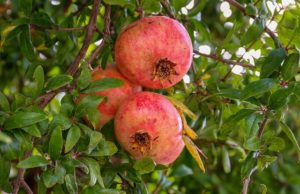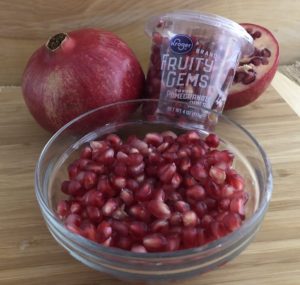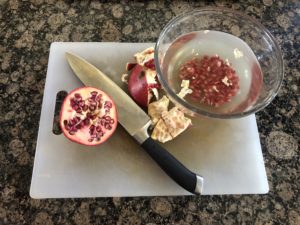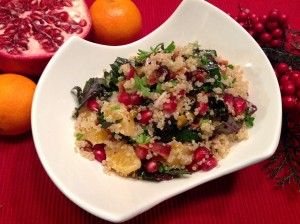 Welcome to pomegranate season!
Welcome to pomegranate season!
If you haven’t seen them already, these ruby-red seasonal fruits should start showing up at your local stores. There was a time when we really weren’t familiar with pomegranates. We had heard of them, but had never tried them. Quite honestly, they don’t really look that attractive on the outside, but it’s definitely what is on the inside that counts!
When we first noticed them at the store, we had no idea what to do with them or what they tasted like. So, we of course took one home and encountered the first challenge…how do we peel it and how do we get all those tiny balls of fruit out without staining everything in sight (including ourselves) in the process?!
Once we figured this out and got our first taste of the juicy, flavor-popping seeds, we were hooked! Whether you are a pomegranate beginner or an expert, there are a few tricks and key things to know that hopefully will help make them even more enjoyable!
What exactly are pomegranates?
 Pomegranates are native to a region from Iran to northern India and they also thrive in the drier climates of California and Arizona. The pomegranate name is derived from Latin and one interpretation is “apple with many seeds.” Most of the pomegranates available in the U.S. come from orchards in California — but they have a short season, typically from October through February. They don’t ripen after they are harvested, so they travel and store well.
Pomegranates are native to a region from Iran to northern India and they also thrive in the drier climates of California and Arizona. The pomegranate name is derived from Latin and one interpretation is “apple with many seeds.” Most of the pomegranates available in the U.S. come from orchards in California — but they have a short season, typically from October through February. They don’t ripen after they are harvested, so they travel and store well.
There are several hundred seeds, or “arils,” in an average pomegranate. The seeds taste sweet and a little tart (they are like tiny juice pockets that burst when you eat them!) and are used in a wide variety of dishes and recipes. They are great to enjoy at Thanksgiving and over the holidays! They are also used to make pomegranate juice and a recent trend is to cook them down to make pomegranate molasses. You can even use pomegranates as fall decorations as long as you keep them cool and dry (but it’s so much more fun to eat them)!
How do you pick them?
Pomegranates should be a deep red or reddish brown color and feel heavy for their size. Try to avoid bruises, cut marks or soft spots and you should be able to pick a perfect pomegranate.
How do you get those great-tasting pesky seeds out?
It’s actually easier than you may think, and there are definitely benefits to buying fresh pomegranates! Check out this video to see how easy it can be.

Yes, you can buy pre-seeded pomegranates. Personally, we don’t recommend this for a couple reasons. First, pre-seeded pomegranates can be ridiculously expensive! We were at the store last week and they were $3 for 4 ounces (a little over 1/2 cup of arils). As a comparison, a fresh pomegranate was $1.29 and yields at least one cup of arils!
Also, the pre-packaged arils don’t last very long after they are seeded…we bought a package of pre-seeded arils from a local store a couple of years ago and the seeds were mushy and moldy within a couple of days.
We favor the submersion method…
 Seeding a pomegranate is super-easy!
Seeding a pomegranate is super-easy!
First, fill a medium size bowl with water. Place a pomegranate half (or quarter) in the bowl, submerged in the water. Pry the seeds out and let them fall to the bottom of the bowl — the white pulp will float on the top of the water. Now all you have to do is scoop out the pulp, remove the seeds from the water and repeat for the rest of the fruit.
Beat it? Some people recommend holding a pomegranate half over a bowl and beating it with a large wooden spoon. This may work well for some, but our experience included a lot of juice coming out along with the seeds — we definitely prefer the submersion method.
How do you store the seeds?
- Eat them very soon! Once a pomegranate is seeded, you need to store them in the refrigerator and eat the arils within 2-3 days or they will begin to go bad.
- Freeze the seeds! Preserve the delicious pomegranate seeds by freezing them — they will keep frozen for up to a year. Defrosted seeds may seem a little mushy, but will still work great in your recipes.
- Shelf life? Pomegranates (whole and not yet seeded) will store in the refrigerator for 3-4 weeks.
Zonya’s Take on the Power of Pomegranates:
Many nutritionists (me included!) assign the pomegranate as one of the top superfoods in the fruit category. Its antioxidant capacity tops the charts, and it is high in vitamin C and potassium. Studies with pomegranates appear promising in lowering cholesterol, blood pressure, and atherosclerosis, in addition to reducing risk of breast, prostate and colon cancer. The phytochemicals in this wonder-fruit may also help fight depression and bone-density loss. Enjoy pomegranates fresh October through February, and as juice (4 oz. serving) March through September to provide a constant intake of this beneficial superfood!
Take the Pomegranate Challenge!
Take advantage of the season and try pomegranates in different ways over the next few weeks. Now that you know how to pick them, seed them and store them…here are some great ideas how to enjoy them!
- Pomegranate Pear Salad
- Christmas Cranberry Salsa
- Dark Chocolate Bark with Pomegranates and Orange Zest
- Pomegranate Christmas Tree Salad
- Christmas Quinoa Salad
 Brussels Sprouts & Winter Squash Gratin
Brussels Sprouts & Winter Squash Gratin- Winter Fattoush Salad
- Roasted Eggplant with Ricotta and Pomegranates
- Roasted Acorn Squash & Brussels Sprouts Salad
- Cauliflower and Kale Detox Salad
- Winter Fruit Salad
- Squash and Chicken Tagine
…just to name a few! You can also add them to your smoothies, oatmeal or on top of your yogurt and granola!
What do YOU do with pomegranates?
We would love to hear your tricks and ideas!
 LEARN MORE ABOUT THE NAPKIN!
LEARN MORE ABOUT THE NAPKIN!


We simply strip the jewels out into tiny bowls so each person sitting in the evening can slowly eat their 2 oz bowlfull.